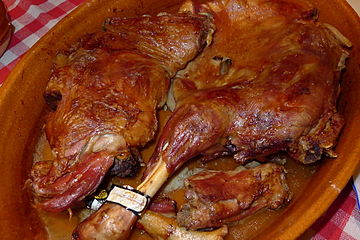Lamb and mutton
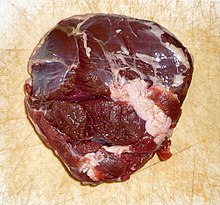
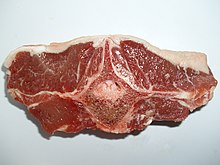
Sheep meat is one of the most common meats around the world, taken from the
In South Asian and Caribbean cuisine, "mutton" often means goat meat.[1][2][3][4][5] At various times and places, "mutton" or "goat mutton" has occasionally been used to mean goat meat.[1]
Lamb is the most expensive of the three types and in recent decades sheep meat is increasingly only retailed as "lamb", sometimes stretching the accepted distinctions given above. The stronger-tasting mutton is now hard to find in many areas, despite the efforts of the Mutton Renaissance Campaign in the UK. In Australia, the term prime lamb is often used to refer to lambs raised for meat.[6] Other languages, such as French, Spanish, and Italian, make similar or even more detailed distinctions among sheep meats by age and sometimes by sex and diet—for example, lechazo in Spanish refers to meat from milk-fed (unweaned) lambs.
Classifications and nomenclature
The definitions for lamb, hogget and mutton vary considerably between countries. Younger lambs are smaller and more tender. Mutton is meat from a sheep over two years old, and has less tender flesh. In general, the darker the colour, the older the animal.
Britain, Australia, and New Zealand
- Lamb — a young sheep which is less than one year old. From 1 July 2019, the Australian definition is "an ovine animal that: (a) is under 12 months of age; or (b) does not have any permanent incisor teeth in wear. This new definition meant that Australians farmers could extend the term "lamb" with another month.[7] This followed a similar definition change in New Zealand in 2018. In Britain the definition is still "0 permanent incisor teeth". A permanent incisor tooth is said to be "in wear" if it protrudes further than the nearest milk teeth.[7]
- Hogget — A term for a sheep of either sex having no more than two permanent incisors in wear,[8] or its meat. In the UK, it means animals that are 11 to 24 months old, while Australian butchers use the term for animals that are 13 to 24 months old.[9][10] Still common in farming usage and among speciality butchers, it is now a rare term in British, Australian and New Zealand supermarkets, where meat of all sheep less than two years old tends to be called "lamb".
- Mutton — the meat of a female (ewe) or castrated male (wether) sheep having more than two permanent incisors in wear.
United States
In the early 1900s, mutton was widely consumed in the United States, but mutton consumption has declined since
Indian subcontinent
The term "mutton" is applied to goat meat in most countries on the Indian subcontinent, and the goat population has been rising. For example, mutton curry is always made from goat meat. It is estimated that over a third of the goat population is slaughtered every year and sold as mutton. The domestic sheep population in India and the Indian subcontinent has been in decline for over 40 years and has survived at marginal levels in mountainous regions, based on wild-sheep breeds, and mainly for wool production.[17]
Other definitions
- Milk-fed lamb — meat from an unweaned lamb, typically 4–6 weeks old and weighing 5.5–8 kg; this is typically unavailable in countries such as the United States and the United Kingdom. The flavour and texture of milk-fed lamb when grilled (such as the small lamb cutlets known as La Rioja. Milk-fed lambs are especially prized for Easterin Greece, when they are roasted on a spit.
- Young lamb — a milk-fed lamb between six and eight weeks old
- Spring lamb — a milk-fed lamb, usually three to five months old, born in late winter or early spring and sold usually before 1 July (in the northern hemisphere).
- Sucker lambs — a term used in Australia[19] — includes young milk-fed lambs, as well as slightly older lambs up to about seven months of age which are also still dependent on their mothers for milk. Carcases from these lambs usually weigh between 14 and 30 kg. Older weaned lambs which have not yet matured to become mutton are known as old-season lambs.
- Yearling lamb — a young sheep between 12 and 24 months old
- Saltbush mutton – a term used in Australia for the meat of mature Merinos which have been allowed to graze on atriplex plants
- Salt marsh lamb (also known as 'saltmarsh lamb' or by its French name, sea lavender. Depending on where the salt marsh is located, the nature of the plants may be subtly different. Salt marsh lamb has long been appreciated in France and is growing in popularity in the United Kingdom. Places where salt marsh lamb are reared in the UK include Harlech and the Gower Peninsula in Wales, the Somerset Levels, Morecambe Bay and the Solway Firth.[20]
- Saltgrass lamb – a type of lamb exclusive to Flinders Island (Tasmania). The pastures on the island have a relatively high salt content, leading to a flavor and texture similar to saltmarsh lamb.[21]
Butchery and cookery
-
Chuletillas of milk-fed lamb in Asturias
-
Abbacchio is an Italian preparation of lamb.
-
Lamb shanks of a young lamb
-
Mutton rogan josh from India
-
LambUyghur grilledlamb kebabs)
The meat of a lamb is taken from the animal between one month and one year old, with a carcass weight of between 5.5 and 30 kg (12 and 66 lb). This meat generally is more tender than that from older sheep and appears more often on tables in some
Lamb is often sorted into three kinds of meat: forequarter, loin, and hindquarter. The forequarter includes the neck, shoulder, front legs, and the ribs up to the shoulder blade. The hindquarter includes the rear legs and hip. The loin includes the ribs between the two.
Lamb chops are cut from the rib, loin, and shoulder areas. The rib chops include a rib bone; the loin chops include only a chine bone. Shoulder chops are usually considered inferior to loin chops; both kinds of chops are usually grilled. Breast of lamb (baby chops) can be cooked in an oven.
Leg of lamb is a whole leg; saddle of lamb is the two loins with the hip. Leg and saddle are usually roasted, though the leg is sometimes boiled.
Forequarter meat of sheep, as of other mammals, includes more connective tissue than some other
Lamb shank definitions vary, but generally include:
- a cut from the arm of shoulder, containing leg bone and part of round shoulder bone, and covered by a thin layer of fat and fell (a thin, paper-like covering).
- a cut from the upper part of the leg.
Mutton barbeque is a tradition in Western Kentucky. The area was strong in the wool trade, which gave them plenty of older sheep that needed to be put to use.[23]
Thin strips of fatty mutton can be cut into a substitute for bacon called macon.
Lamb tongue is popular in Middle Eastern cuisine both as a cold cut and in preparations like stews.[24]
Cuts
UK, Canada, and other Commonwealth countries

Approximate zones of the usual UK cuts of lamb:[25]
- Scrag end (of neck)
- Middle neck
- Best End (of neck)
- Loin
- Chump (and chump chops)
- Leg (gigot in Scotland)
- Shank
- Shoulder
- Breast
US and Ireland
- Square cut shoulder – shoulder roast, shoulder chops and arm chops
- Rack – rib chops and riblets, rib roast
- Loin – loin chops or roast
- Leg – sirloin chops, leg roast (leg of lamb)
- Neck
- Breast
- Shanks (fore or hind)
- Flank
New Zealand
- Forequarter
- Neck – neck chops
- Shoulder – shoulder chops, shoulder roast (usually boned and rolled)
- Rib-eye
- Breast
- Knuckle
- Loin
- Rib-loin – racks, frenched cutlets, spare ribs
- Mid-loin – striploin (backstrap), loin chops
- Tenderloin
- Flap
- Full leg – leg roast (may be boned and rolled), leg chops. A short-cut leg is a full leg without the chump; a carvery leg is a short-cut leg without the thick flank
- Chump (rump) – chump chops, rump steak
- Thick flank (knuckle) – schnitzel
- Topside & silverside – steaks
- Shank
Production and consumption figures
Sheep meat consumption
According to the
Sheep meat production
The table below gives a sample of producing nations, but many other significant producers in the 50–120 kt range are not given.
| 2008 | 2009 | 2010 | 2011 | 2012 | |
|---|---|---|---|---|---|
World |
8,415 | 8,354 | 8,229 | 8,348 | 8,470 |
| 179 | 197 | 205 | 253 | 261 | |
| 660 | 635 | 556 | 513 | 556 | |
| 79 | 80 | 82 | 84 | 85 | |
| 1,978 | 2,044 | 2,070 | 2,050 | 2,080 | |
| 130 | 126 | 119 | 115 | 114 | |
| 38 | 38 | 38 | 39 | 36 | |
| 91 | 90 | 90 | 90 | 90 | |
| 275 | 286 | 289 | 293 | 296 | |
| 113 | 128 | 113 | 113 | 113 | |
| 170 | 114 | 90 | 104 | 126 | |
| 110 | 116 | 123 | 128 | 128 | |
| 598 | 478 | 471 | 465 | 448 | |
| 145 | 149 | 171 | 172 | 174 | |
| 156 | 164 | 167 | 171 | 173 | |
| 278 | 262 | 240 | 253 | 272 | |
| 124 | 128 | 130 | 130 | 133 | |
| 326 | 307 | 277 | 289 | 275 | |
| 81 | 80 | 76 | 69 | 72 | |
| Source: Helgi Library,[31] World Bank, FAOSTAT | |||||
Dishes
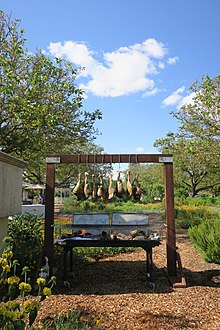

Meat from sheep features prominently in the cuisines of several
Mutton is also popular in
In Australia, the leg of lamb roast is considered to be the national dish.[32] Commonly served on a Sunday or any other special occasion, it can be done in a kettle BBQ or a conventional oven. Typical preparation involves covering the leg of lamb with butter, pushing rosemary sprigs into incisions cut in the leg, and sprinkling rosemary leaves on top. The lamb is then roasted for two hours at 180 °C (350 °F) and typically served with carrots and potato (also roasted), green vegetables and gravy.
In
In Mexico, lamb is the meat of choice for barbacoa, in which the lamb is roasted or steamed wrapped in maguey leaves underground.[35]
In
Organ meats/offal
Lamb's liver, known as lamb's fry in New Zealand and Australia,[36] is eaten in many countries. It is the most common form of offal eaten in the UK, traditionally used in the family favourite (and pub grub staple) of liver with onions, potentially also with bacon and mashed potatoes. It is a major ingredient, along with the lungs and heart (the pluck), in the traditional Scottish dish of haggis.
Lamb testicles or lamb fries are a delicacy in many parts of the world.
Lamb kidneys are found in many cuisines across Europe and the Middle East, often split into two halves and grilled (on kebabs in the Middle East), or sautéed in a sauce. They are generally the most highly regarded of all kidneys.
Lamb sweetbreads are a delicacy in many cuisines.[37]
Environmental impact
| Food Types | Land Use (m2year per 100g protein) |
|---|---|
| Beef | 50
|
| Lamb and Mutton | 20
|
| Cheese | 11
|
| Pork | 7.6
|
| Farmed Fish | 6
|
| Poultry | 5.7
|
Eggs
|
4.2
|
| Tofu | 2
|
| Groundnuts | 1.2
|
Peas
|
0.4
|
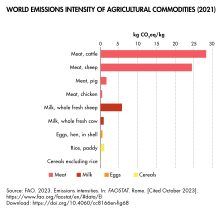
Production of lamb emits more greenhouse gas per gram of protein than other common foods, except for beef.[39]

See also
- Lechazo de Castilla y León – milk-fed lamb meat from Spain
- List of lamb dishes
- Mutton curry
- Mutton flaps
- Goat meat
- Sheep's trotters
- Smalahove – a Western Norwegian dish of sheep head
Bibliography
- K.F. Warner, "Boning Lamb Cuts", Leaflet 74, U.S. Department of Agriculture, Bureau of Animal Industry, June 1931. full text
- Bob Kennard, "Much ado about mutton". Ludlow: Merlin Unwin, 2014 [40]
Notes
- ^ a b Oxford English Dictionary, 3rd edition, June 2003, [https://www.oed.com/view/Entry/124371 s.v., definition 1b
- ^ "Whose goat is it anyway?". Hindustan Times. 11 February 2012. Retrieved 15 May 2015.
- ISBN 9780143414568
- ISBN 0375712119, p. 49
- ISBN 1883323878 p. 81
- ^ Australian Prime Lamb Industry, 2000 Archived 13 April 2011 at the Wayback Machine
- ^ a b "Australia's New Definition of Lamb – What You Need to Know" (4 July 2019). SheepProducers.com.au. Retrieved 28 September 2019.
- ^ Delbridge, Arthur, "The Macquarie Dictionary", 2nd ed., Macquarie Library, North Ryde, 1991
- ^ What is the difference between lamb, hogget & mutton? Farmison & Co (British online butcher). Retrieved 27 August 2022.
- ^ Lamb versus Hogget Meat: What's the Difference? Border Parks Organics (Australian online butcher). Retrieved 27 August 2022.
- ^ Fogarty, Lisa (26 November 2019). "After WW2 mutton fell out of favor in the U.S." NPR. Retrieved 17 March 2020.
- ^ "Lamb Sector at a Glance". United States Department of Agriculture. Retrieved 17 March 2020.
- ^ Merriam-Webster Dictionary, s.v. hogget Archived 7 November 2017 at the Wayback Machine: "chiefly British"
- ^ 7 CFR 65.190
- ^ "Yearling Lamb" (PDF). United States Department of Agriculture. Retrieved 17 March 2020.
- ^ "Lamb from farm to table". United States Department of Agriculture. Retrieved 17 March 2020.
- ^ "Sheep (new, with animal welfare information) | Infonet Biovision Home". infonet-biovision.org. Retrieved 17 June 2022.
- ^ "Speleogroup – sg2012". speleogroup.org.
- ^ "Australian Sheep CRC". sheepcrc.org.au.
- ^ Keating, Sheila."Food Detective: Salt Marsh Lamb Archived 13 October 2008 at the Wayback Machine." The Times Online, 28 June 2008.
- ^ Bastick, C. H. and Walker, M. G, Extent and impacts of Dryland Salinity in Tasmania. "[1]" Department of Primary Industries, Water and Environment, August 2000.
- ^ Fearnley-Whittingstall, Hugh. "What Is Mutton – Understanding the History Archived 23 July 2017 at the Wayback Machine." Mutton Renaissance.
- ^ "Owensboro Kentucky Mutton Barbecue".
- ^ "Lebanese Recipes, Lamb Tongue Salad, oregano, pepper, salt ginger". discoverlebanon.com.
- ISBN 0-600-60235-4
- ^ "Beef + Lamb New Zealand Reference Guide" (PDF). Retrieved 10 June 2021.
- ^ Nicol, Alistair; Saunders, Caroline (24 November 2008). "Lamb cuts". teara.govt.nz. Retrieved 10 June 2021.
- ^ Meat consumption, OECD Data. Retrieved 25 October 2016.
- ^ "2018 Red Meat Market Snapshot" (PDF). Meat and Livestock Australia. Retrieved 17 December 2018.
- ^ a b c "Is the UK unusually fond of lamb and potatoes?". BBC News. 2 September 2014.
- ^ "HelgiLibrary - Sheep Meat Production". helgilibrary.com.
- ^ "Roast lamb rules as Australia's national dish". 2 February 2010.
- ISBN 9780711212732. Retrieved 7 July 2010.
- ^ Susilowati Primo (21 March 2013). "Lamb curry (gulai kambing)". Food.
- ^ "Steamed meat: Igbo translation, definition, meaning, synonyms, pronunciation, transcription, antonyms, examples | HTML Translate | English - Igbo Translator | OpenTran". en.opentran.net. Retrieved 17 June 2022.
- ^ Delbridge, Arthur, The Macquarie Dictionary, 2nd ed., Macquarie Library, North Ryde, 1991
- ^ *Sweetbread recipes BBC food
- "Sweetbreads" Archived 5 November 2016 at the Wayback Machine, British Food: A History
- PMID 29853680.
- ^ "Interactive: What is the climate impact of eating meat and dairy?". url. Retrieved 5 June 2021.
- ^ "Much Ado About Mutton". www.merlinunwin.co.uk.

